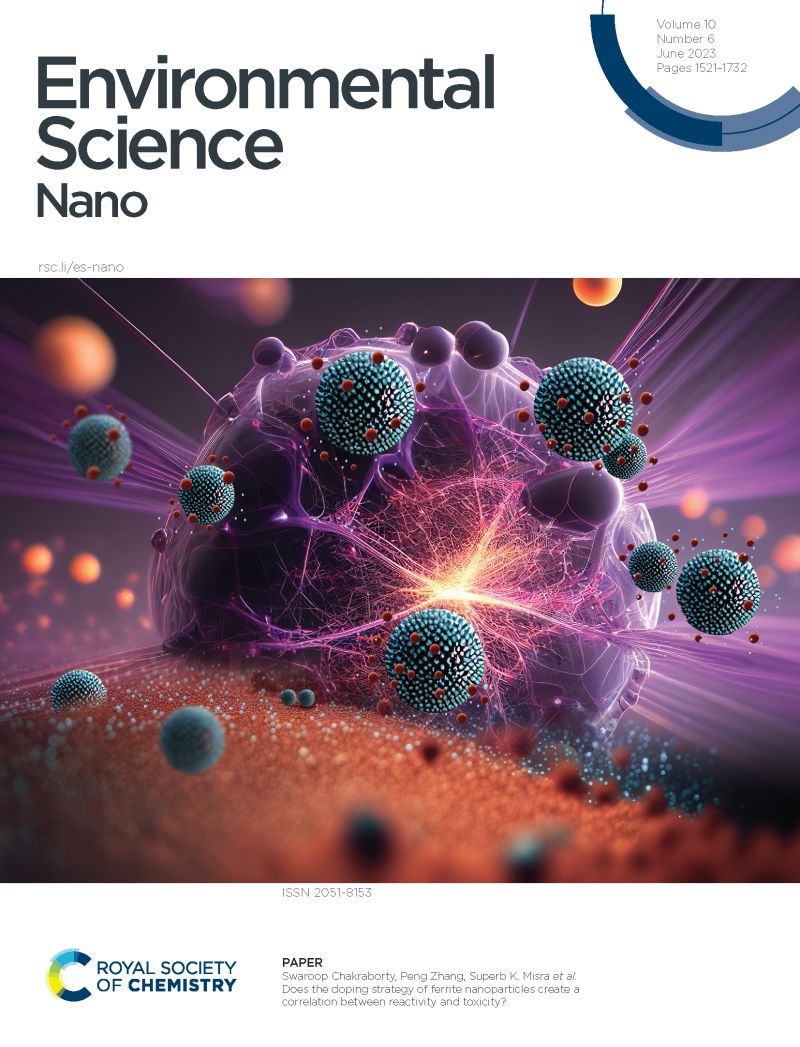叶面喷施纳米氧化铈颗粒对紫花苜蓿(Medicago sativa L.)生长双面效应的多重启示
IF 5.8
2区 环境科学与生态学
Q1 CHEMISTRY, MULTIDISCIPLINARY
引用次数: 0
摘要
纳米技术应用广泛,但过度使用纳米技术带来的污染和毒性也必须引起重视。本文研究了氧化铈纳米粒子(CeO2 NPs)通过调节细胞程序性死亡(PCD)对紫花苜蓿(Medicago sativa L.)的双重影响。在这里,对紫花苜蓿叶面喷洒 CeO2 NPs 表明了 CeO2 NPs 的剂量依赖效应。低浓度的 CeO2 NPs 有积极作用,但高浓度的 CeO2 NPs 有植物毒性。具体而言,100 mg L-1 CeO2 NPs 可改善紫花苜蓿的形态、生物量、色素、光合作用、气孔开放、超微结构、渗透和氧化还原平衡、抗氧化酶和抗 PCD 基因以及多种激素,同时降低促进 PCD 的基因表达和细胞特征。相反,1000 mg L-1 CeO2 NPs 则会诱导 PCD,导致氧化损伤、负形态、质量下降、高 Ce 积累、光合作用减弱、气孔关闭、脂质过氧化、细胞凋亡、细胞超微结构受损、DNA 断裂、渗透和氧化还原不稳定、基因改变和激素波动。总之,紫花苜蓿通过控制 PCD 对 CeO2 NPs 的双重性做出了反应,而 PCD 是由一个复杂的网络调控的。该研究为合理利用 CeO2 NPs、促进可持续农业发展和防止纳米材料造成的环境污染提出了新的展望。本文章由计算机程序翻译,如有差异,请以英文原文为准。
Multiple insights into the two-sided effects of foliar application of cerium oxide nanoparticles on the growth of alfalfa (Medicago sativa L.)
Nanotechnology has a wide range of applications, and the pollution and toxicity of their overuse must also be taken seriously. The dual effects of cerium oxide nanoparticles (CeO2 NPs) on alfalfa (Medicago sativa L.) through regulating programmed cell death (PCD) were investigated. Herein, foliar spray of CeO2 NPs on alfalfa revealed a dose-dependent effect of CeO2 NPs. CeO2 NPs at low concentrations had a positive effect but at high concentrations had a phytotoxicity. Specifically, 100 mg L-1 CeO2 NPs improved morphology, biomass, pigments, photosynthesis, stomatal opening, ultrastructure, osmotic and redox homeostasis, the antioxidant enzyme and the anti-PCD genes, and several hormones, accompanied by lower PCD-promoting gene expression and cellular features. Conversely, 1000 mg L-1 CeO2 NPs induced PCD by causing oxidative damage, along with negative morphology, reduced quality, high Ce accumulation, weak photosynthesis, stomatal closure, lipid peroxidation, apoptosis, impaired cellular ultrastructure, DNA fragmentation, osmotic and redox instability, gene alterations, and hormonal fluctuations. Overall, alfalfa responds to the duality of CeO2 NPs by controlling PCD, which is regulated by a complex network. It proposes a fresh outlook on the rational utilization of CeO2 NPs, the promotion of sustainable agriculture, and the prevention of environmental pollution caused by nanomaterials.
求助全文
通过发布文献求助,成功后即可免费获取论文全文。
去求助
来源期刊

Environmental Science: Nano
CHEMISTRY, MULTIDISCIPLINARY-ENVIRONMENTAL SCIENCES
CiteScore
12.20
自引率
5.50%
发文量
290
审稿时长
2.1 months
期刊介绍:
Environmental Science: Nano serves as a comprehensive and high-impact peer-reviewed source of information on the design and demonstration of engineered nanomaterials for environment-based applications. It also covers the interactions between engineered, natural, and incidental nanomaterials with biological and environmental systems. This scope includes, but is not limited to, the following topic areas:
Novel nanomaterial-based applications for water, air, soil, food, and energy sustainability
Nanomaterial interactions with biological systems and nanotoxicology
Environmental fate, reactivity, and transformations of nanoscale materials
Nanoscale processes in the environment
Sustainable nanotechnology including rational nanomaterial design, life cycle assessment, risk/benefit analysis
 求助内容:
求助内容: 应助结果提醒方式:
应助结果提醒方式:


